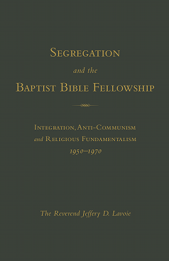Segregation and the Baptist Bible Fellowship: Integration, Anti-Communism and Religious Fundamentalism, 1950 – 1970
LL.D, History Ph.D Programme Exeter University
 This research monograph is an historical study of the Baptist Bible Fellowship and its connections with segregation during the 1950s. It includes an examination of some of its key founders and their views of segregation and observes some of the crucial figures who fought for racial equality and integration within this organization. Though many of the founders of this Baptist denomination were segregationists (which could be considered racist in and of itself) some of these individuals held blatant racist views of white supremacy. What is intriguing is that many of these founders met with violent and scandalous fates . In this work the author observes the racial views of some founding members and how these institutional opinions have influenced and changed (or not) this autonomous organization over the years.
This research monograph is an historical study of the Baptist Bible Fellowship and its connections with segregation during the 1950s. It includes an examination of some of its key founders and their views of segregation and observes some of the crucial figures who fought for racial equality and integration within this organization. Though many of the founders of this Baptist denomination were segregationists (which could be considered racist in and of itself) some of these individuals held blatant racist views of white supremacy. What is intriguing is that many of these founders met with violent and scandalous fates . In this work the author observes the racial views of some founding members and how these institutional opinions have influenced and changed (or not) this autonomous organization over the years.
No standard published history of the Baptist Bible Fellowship (BBF) currently exists which would makes this work an important contribution to modern American history, the history of racism in the United States, and modern religious movements in the post war world in general.
A Study on Racism within the Baptist Bible Fellowship
This section will include an introduction to this study including the author’s intentions and a basic contextual background of the 1950s introducing the cultural climate. This background includes a brief analysis of the ‘communist paranoia’ which fueled the BBF founders’ views of racial segregation and served as one of the factors behind their refusal to comply with the civil rights movement. This section will also suggest a definition for both racism and segregation and engage the question, “Are the terms ‘
segregation’ and ‘racism’ synonymous?”
II. The Founders of the BBF
This second chapter deals with the divisive issues which led to the foundation of the Baptist Bible Fellowship out of J. Frank Norris and his World Fundamental Baptist Missionary Fellowship (WFBMF). This chapter will introduce key figures and personalities associated with the early BBF. The final part of this section will reprint a ‘segregation resolution’ decided upon in a BBF meeting on 28 November 1957 at Castleberry Baptist Church in Ft. Worth, TX where this resolution was passed and agreed upon by over 1,000 churches in the BBF to support racial segregation.
III. The First Generation and Segregation
This section will delve into the personal lives and racial views of some early BBF associated figures such as J. Frank Norris, G. B. Vick, Noel Smith, Homer G. Ritchie, and George E. Hodges ( the former having been tragically murdered by his mistress in the church parking lot). The main purpose of this chapter will be to examine these individuals and their views of racial segregation. This examination will identify some of the common elements and Bible stories that these figures employed in order to justify their views of racial oppression. Most of these pastors held that racial integration was the tool of the ‘Satanic’ communist party to produce the one world government hinted at in the Tower of Babel story in Genesis that would eventually usher in the apocalypse as described in the book of Revelation.
IV. Radicals and Reformers
This chapter seeks to identify and research the lives of two pastors on opposite ends of the spectrum- one of these individuals was J. H. ‘Dick’ Melton (1922 -1995) who held and taught racist ideologies at a BBF institution (Baptist Bible College in Springfield, MO) and the other opposing figure was an integrationist named Truman E. Dollar (1938?- 1996) who was influential in the BBF until he was exposed by his own son for participating in a sexually explicit conversation with a married woman which resulted in Dollar’s tragic suicide. Melton drew upon the segregationist ideas which the BBF founders had misinterpreted out of the Bible (especially the ‘Hamitic Curse’) and used these beliefs to justify the supremacy of the white race; whereas, Dollar sought to racially integrate his church (Temple Baptist Church) which happened to be the pastorate of the founder of the BBF G. B. Vick. During his lifetime, Vick (the founder of the BBF) had refused to baptize and offer membership to black people- a rule which was enforced until the 1980s when Dollar worked to integrate this institution.
V. The Impact of the History
This section examines the recent history of the ‘Brothers of Cyrene’- a group of black pastors which was established in 2007 to function within the BBF. It appears that the very premise of this organization is to continue planting racially segregated churches. This segregation seems to be the main goal of the ‘Nehemiah project’ an idea which attempts to plant black churches out of predominantly white congregations. This program calls on black members within already established BBFI churches to form their own separate church so that they are able to minister to people of their own race- again the questions arises over segregation just at the moment (2012)that the Southern Baptist Convention will for the first time be headed by an Afro-American.
ACADEMICA PRESS
1727 Massachusetts Avenue, NW, Suite 507
Washington, DC 20036
